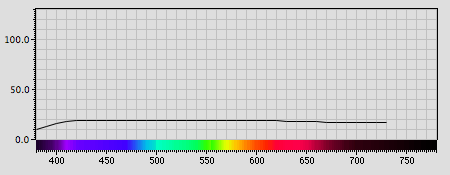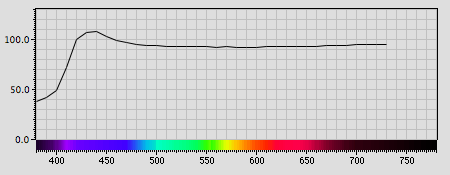Gray or White Card for Neutral Balancing?
Although the camera calls it "white balance", most cameras do not actually use a white card to perform this operation. Instead, they use a gray card, or a white card exposed so it appears gray. More properly white balance should be called neutral balance or, even better, light balance. What is actually happening is the balance between the color channels in the camera (red, green and blue, usually) are adjusted so a gray item will produce an image with equal RGB values under a given lighting.
Gray
A gray item is used because the reflectance across the spectrum is ideally the same, so it does not add any color of its own to the light reflected from it when used to make the neutral balance.
The following is the spectrum for the N5 patch of a ColorChecker®. The reflectance is very flat almost completely across the spectrum.

White
There are several reasons not to use a white card to set the balance.
The most commonly used white colorant is titanium dioxide which does not reflect light evenly across the spectrum. It is a pale yellow but the human visual system adjusts to make it appear white. A digital camera will sense the slight yellowness and create a slightly blue balance to counteract the yellow. So the images will be slightly bluish, which the color management system often adjusts with yellow highlight dots when printing.
Here is the spectrum for the ColorChecker® white patch. It shows a sharp decrease in violet to deep blue reflectance and an increase in reflectance as the spectrum progresses from blue to red. This is typical of a titanium dioxide white colorant.

Many white items used to set the neutral balance, such as white paper, have fluorescent whitening agents used to make the material appear whiter. These whitening agents convert invisible ultraviolet light to visible blue light, counteracting the natural yellowness of the material and making it look very white and bright. The neutral balance then depends on the amount of ultraviolet light present in the illumination. Lamps with low ultraviolet light output, such as tungsten or tungsten-halogen, will produce a different appearance with an optically brightened paper than fluorescent lighting with a higher ultraviolet component.
The following reflectance spectrum for Epson Glossy Heavyweight paper displays a reflectance similar to titanium dioxide but with the addition of an extra reflectance peak at 430 nm in the blue. This blue reflectance is caused by a fluorescent whitening agent (FWA), also known as an optical brightening agent (OBA).

Another mark against white cards is that most digital cameras overexpose images by 2/3 to 1 EV (f/stop). This makes it easy to overexpose the white card, making the neutral balance invalid because once the sensor channels are overexposed, it is impossible to balance the channels properly. The cameras overexpose deliberately to produce more shadow detail at the expense of losing highlight detail.
A white card does have its uses for digital photography when used to set the exposure. In the days of film photography, an 18% reflective gray card was used to set the exposure. It was not used to set the neutral balance because that was built into the film by the manufacturer. These days, digital cameras do not set the exposure with a gray card, instead they use the gray to set the neutral balance. Exposing the white card then checking the image histogram is an effective way to use a white card to make sure highlight detail is not lost.
The term "white balance" will probably not go away, but photographers should be aware of what is really happening with the camera and the limitations of the materials used to set the neutral balance.
Experiment
You can verify that a titanium dioxide white is pale yellow by carefully neutral balancing an image of a ColorChecker on either of the two middle gray patches. Capture the image and check the RGB values for the white patch. You should see higher red and green values, indicating a slightly yellow color.
Measurement Notes
All the measurements on this page were made with a GretagMacbeth Spectrolino® equipped with a D65 filter. Four measurements were made of each specimen and averaged together for the result. The spectral data was collected, averaged and graphed with the SpectraShop 2 program.
Updated 30.4.2008
Back to Color Information table
